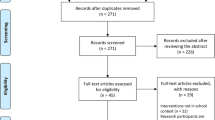Abstract
Although multisensory environments (MSE) are popular in schools educating students with severe disabilities, little is known about how teachers are using them. This paper reports on interviews with five teachers from two special schools who agreed to be videorecorded while using the room with their classes and who were interviewed about their perspectives on MSEs and about the activities observed in their classes. Most teachers seemed to believe that use of the MSE or the equipment in it would have automatic and remarkably wide ranging benefits for their students. There was more limited evidence of focused programing, teaching and monitoring practices that would result in functional outcomes for students. Given lack of empirical support for educational outcomes from MSE use, the authors call for more research on use of MSEs and for education authorities, schools, and teachers to more actively monitor and evaluate the effects of their use.
Similar content being viewed by others
References
Ayer, S. (1998). Use of multi-sensory rooms for children with profound and multiple learning disabilities. Journal of Learning Disabilities for Nursing, Health and Social Care, 2, 89–97. doi:10.1177/146900479800200206.
Botts, B. H., Hershfield, P. A., & Christensen-Sandfort, R. J. (2008). Snoezelen®: empirical review of product representation. Focus on Autism and Other Developmental Disorders, 23, 138–147. doi:10.1177/1088357608318949.
Bozic, N. (1997). Constructing the room: multi-sensory rooms in educational contexts. European Journal of Special Needs Education, 12, 54–70. doi:10.1080/0885625970120106.
Carter, M., & Stephenson, J. (2010). The use of multi-sensory environments in schools servicing children with severe disabilities. Manuscript submitted for publication.
Cavet, J., & Mount, H. (1995). Multisensory environments. In J. Hogg & J. Cavet (Eds.), Making leisure provision for people with profound learning and multiple disabilities (pp. 67–83). London: Chapman & Hall.
de Bunsen, A. (1994). A study in the implication of the Snoezelen resources at Limington House School. In R. Hutchinson & J. Kewin (Eds.), Sensations and disability: Sensory environments for leisure, snoezelen, education and therapy (pp. 138–162). Chesterfield: Rompa.
Hogg, J., Cavet, J., Lambe, L., & Smeddle, M. (2001). The use of “Snoezelen” as multisensory stimulation with people with intellectual disabilities: a review of the research. Research in Developmental Disabilities, 22, 353–372. doi:10.1016/S0891-4222(01)00077-4.
Houghton, S., Douglas, G., Brigg, J., Langsford, S., Powell, L., West, J., et al. (1998). An empirical evaluation of an inter-active multi-sensory environment for children with disability. Journal of Intellectual & Developmental Disability, 23, 267–278. doi:10.1080/13668259800033761.
Hutchinson, R., & Kewin, J. (1994). Sensations and disability. UK: ROMPA.
Lai, C. Y. (2003). The use of multisensory environments on children with disabilities: a literature review. International Journal of Therapy and Rehabilitation, 10, 358–363.
Lancioni, G. E., Cuvo, A. J., & O’Reilly, M. F. (2002). Snoezelen: an overview of research with people with developmental disabilities and dementia. Disability and Rehabilitation, 24, 175–184. doi:10.1080/09638280110074911.
Pagliano, P. (1997). The use of a multisensory environment in the education of children with severe multiple disabilities. In M. Caltabiano, R. Hill, & R. Frangos (Eds.), Achieving inclusion: Exploring issues in disability (pp. 73–93). Townsville: Centre for Social Welfare Research, James Cook University.
Pagliano, P. (1998). The multi-sensory environment: an open-minded space. The British Journal of Visual Impairment, 16, 105–109. doi:10.1177/026461969801600305.
Pagliano, P. (1999). Multisensory environments. London: David Fulton.
Stephenson, J. (2002). Characterization of multisensory environment: why do teachers use them? Journal of Applied Research in Intellectual Disabilities, 15, 73–90. doi:10.1046/j.1360-2322.2002.00102.x.
Stephenson, J., & Carter, M. (in press). The use of multisensory environments for students with severe disabilities: perceptions from schools. Education and Training in Autism and Developmental Disabilities
Weinstein, M. (2008). TAMS Analyzer: A qualitative research tool (Version 3.44) [Computer Software]. Tacoma: Mayday Softworks.
Author information
Authors and Affiliations
Corresponding author
Appendix
Appendix
Individual Teacher Interviews
Before Watching Video
Did you receive any guidance in how to use the MSE?
Thinking about the class you currently teach and use the MSE with,
Do you use the MSE for passive leisure activities? (That is, students use the MSE in an undirected way, adults may activate the equipment for them) If so, how?
Do you use the MSE to assess student skills or behavior? If so, How?
Do you use the MSE to actively teach skills? (For example, do students learn to express preferences for equipment, use switches or other ways of activating equipment?) If so, some examples of skills and how taught.
Do you program and plan for a session in the MSE, or is your use spontaneous—following the student’s lead.
If you do program and plan—how do you do that?
Move to Watch the Video Together
Ask the teacher to talk you through how the session proceeds.
Probe—for each piece of equipment and interaction with a student—Why did you do that (use that particular piece of equipment in that way?) What outcomes or effects do you think that will have?
What specific student outcomes have you seen in your students as a result of using the MSE?
What general benefits do you see from the MSE?
Have you experienced any problems or difficulties using the MSE?
If not arising during the discussion of the videorecording
There are a range of benefits that have been claimed for MSEs. What are your thoughts on these in relation to the students in our class?
-
Benefits of sensory stimulation?
-
Opportunity to relax—a break from the demands of others?
-
Motivator to learn (such as communication and/or motor skills, switch use)?
-
Calming agitation and improving challenging behavior?
-
Improving attention to tasks after a session?
-
Opportunity to build positive relationships with staff?
-
Opportunity to control the environment (through switches for example)?
-
Opportunity to build trust?
-
Opportunity to explore and build cognitive skills?
Rights and permissions
About this article
Cite this article
Stephenson, J., Carter, M. The Use of Multisensory Environments in Schools for Students with Severe Disabilities: Perceptions from Teachers. J Dev Phys Disabil 23, 339–357 (2011). https://doi.org/10.1007/s10882-011-9232-6
Published:
Issue Date:
DOI: https://doi.org/10.1007/s10882-011-9232-6




